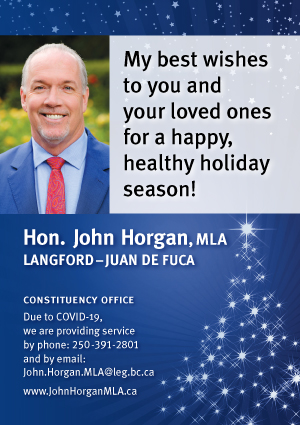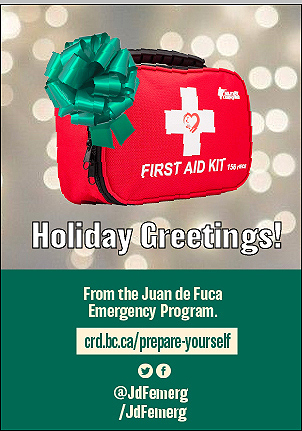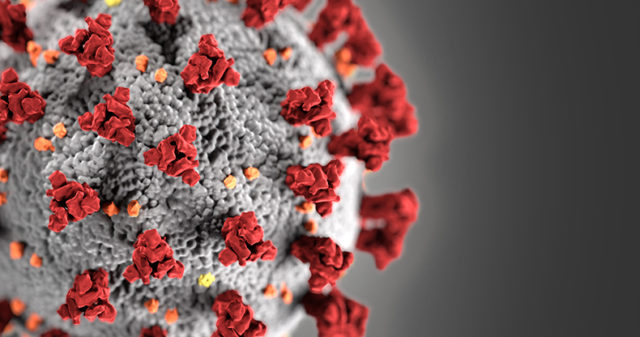
Friday December 18, 2020 | VICTORIA, BC
by Mary P Brooke, B.Sc., editor | Island Social Trends
This week included a significant highlight in the COVID-19 story of 2020. The first vaccines against the SARS-CoV-2 (aka COVID-19) virus arrived in BC and were administered with some appropriate fanfare to mark the historic moment of beginning to turn the tide of the year-long pandemic.
Not that any us are truly numb to the COVID numbers — some days they continue to be shocking (like record-setting daily case counts or deaths). But reports of case numbers, outbreaks and deaths have become almost routine.
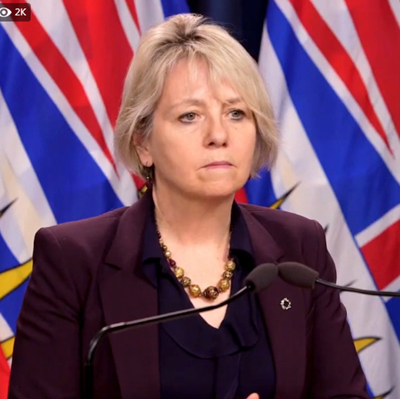
This is where a parallel to wartime can be drawn… the daily trauma to families that is seen through these numbers. One day, hopefully in 2021, when the data stream becomes less dramatic as vaccinations increase and infection levels diminish, we will realize how continually bombarded we have been with the load of the daily COVID reality.
The pandemic is turning a corner. This week a new thread of data has been added to the BC Centre for Disease Control (BC CDC) stats, and that is the number of vaccinations done.
Vaccines this week:
This has been Week 1 for having COVID-19 vaccines in BC (or anywhere across Canada). A significant milestone. Dr Henry attended the immunization clinic in the lower mainland on Tuesday December 15 to witness the first vaccine being administered to a frontline health-care worker.
This week 2,592 doses of the Pfizer-BioNTech mRNA COVID vaccines were administered to frontline health-care workers. Of those, 1,376 were administered in the last 24 hours.
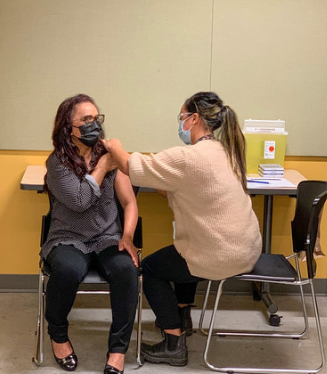
Under the direction of the Public Health Officer, Dr Bonnie Henry, in BC the second booster doses are not being held back for use by the same first set of recipients. In other provinces the second dose set is being held in refrigeration for use three weeks ahead. Dr Henry said she felt it to be more appropriate that as many at-risk workers receive a first-dose, and in-so-doing is holding Pfizer to account to deliver the next batch on time.
“The focus of our immunization program right now is to safely protect as many people as possible as efficiently as we can, but we have to remember that this is a global effort with many aspects often changing,” it was stated in a joint news release from Dr Henry and Health Minister Adrian Dix today. “As more vaccine arrives in the coming weeks, we all need to be patient and continue to follow public health orders to keep our communities safe.”
BC case profile at December 18:
Total COVID cases to date this year in BC come to 45,400 (405 epi-linked) of which 9,978 are presently active. In the total case count, 624 are new today.
The highest number of cases are in the densely populated Fraser Health region, as well as the Vancouver Coastal health region — both in the BC lower mainland. Some increases have been seen in Interior and Northern Health regions, which Health Minister Adrian Dix said earlier this week was ‘troubling’.
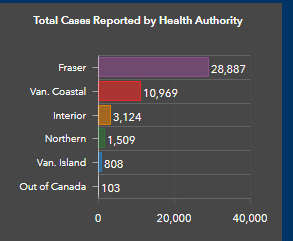
On Vancouver Island the new-case numbers have simmered down a bit in the last week or so, likely reflecting an attentive response to Dr Henry’s extension of public health orders on December 7 (for another month, to midnight on January 8, 2021).
There are 356 people in hospital due to COVID, with 92 of those in intensive care or critical care. Total hospitalizations this year come to 2,461.
Under public health surveillance are 10,211 people who have been exposed to known cases of COVID-19 (that’s been a pretty consistent number for many weeks this fall and early winter); these people are the likely pool of next-known active cases.
A total of 33,589 people have recovered (they have tested negative for COVID-19 after having been positive). Some or many of these people may have short, mid-range, or long-term health impacts from having had the SARS-CoV-2 viral infection. People who have COVID-related health impacts after infection are becoming known as the ‘long-haulers’.
Age profiles:
The highest number of cases by age during the pandemic to date in BC have been among people in their 20s, followed by people in their 30s, 40s, and 50s.
The highest number of hospitalizations has been seen among people in their 70s, followed by 60s and 80s, then 50s.
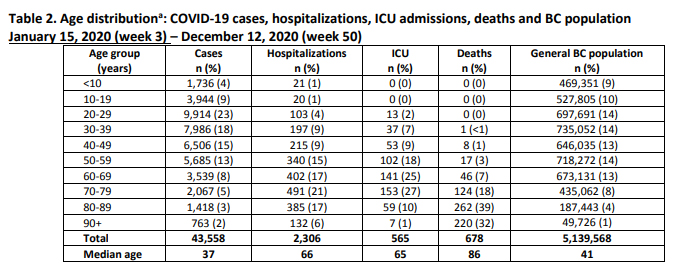
The COVID-19 virus seems to be sparing children (and/or they are infected but asymptomatic — without routine testing of asymptomatic children it’s hard to know for sure). Children under age 20 years are under-represented overall among COVID-19 cases (13%) as well as for severe outcomes (2% or less), relative to their share of the BC general population (19%). Dr Henry has said that most of the cases in the broad range of age 10 to 19 are seen at the top end, i.e. in ages 18 and 19.
Deaths in BC by COVID:
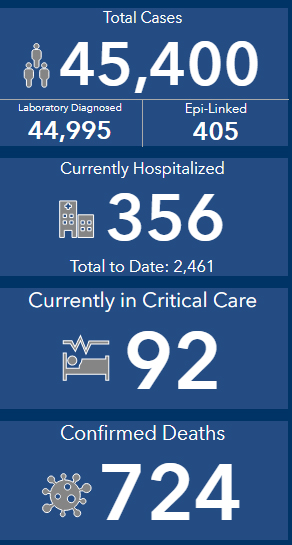
Another 11 deaths were reported today, bringing the total of COVID-19 deaths in BC during the pandemic so far to 724. “We offer our condolences to everyone who has lost their loved ones during the COVID-19 pandemic,” say Dr Henry and Minister Dix.
Most deaths are occurring among people in their 80s, then 90s, and then 70s. No one under the age of 30 has died from COVID-19 in BC.
Testing for COVID:
A total of 1,363,251 COVID tests have been done across all BC health authorities this year to date. In just the last 24 hours 11,529 tests were done… usually on people who or either showing symptoms or are believed to have been exposed.
There continues to be a call for the use of rapid tests on a frequent or daily basis in long-term care (to assist with containing spread among residents and workers) but Dr Henry continues to indicate that the rapid test technology is not optimally reliable. Conserving resources for people with symptoms and/or known exposure continues to be the evident priority for testing.
Vancouver Island case profile at December 18:
There have been 808 cases of COVID-19 to date on Vancouver Island (within Island Health). Five of the cases are new today: three among people in their 20s, one in a person in their 40s, and one a person in their 60s.
There are 62 presently active cases. Within those, five people are in hospital (one in ICU or critical care). Total hospitalizations to date comes to 49 in Island Health.

There was another death in Island Health reported today, bringing the island total to 10 during the pandemic (1.38% of total COVID deaths in BC). There have been three deaths on Vancouver Island in the last week (two, and possibly the third, associated with the outbreak at Saanich Peninsula Hospital).
A total of 150,033 COVID tests have been done within Island Health this year to date. In just the last day 1,043 tests were done.
Outbreaks & Exposures:
Today there were no new health-care facility outbreaks to report. There has been one new community outbreak at Rossdown Natural Foods (a chicken and turkey processing facility in Abbotsford).
There are presently five exposures in schools on Vancouver Island: three in Nanaimo, one in Campbell River, and one on Salt Spring Island. Dr Henry continues to explain how schools are a controlled environment where the risk of COVID-19 transmission is low, controlled and/or contained (nipped in the bud when it happens).
There have been no reported COVID exposures or outbreaks in schools in the west shore or Sooke (Sooke School District SD62) this year to date. This week SD62 Chair Ravi Parmar commended staff for all they’ve done to keep the school community safe. A notable decision for the secondary-school level (taking just one class for five weeks at a time, times eight cycles in the year) seems to have been the right decision for comfort level as well as learning (many students are finding the concentration on one course at a time to be helpful).
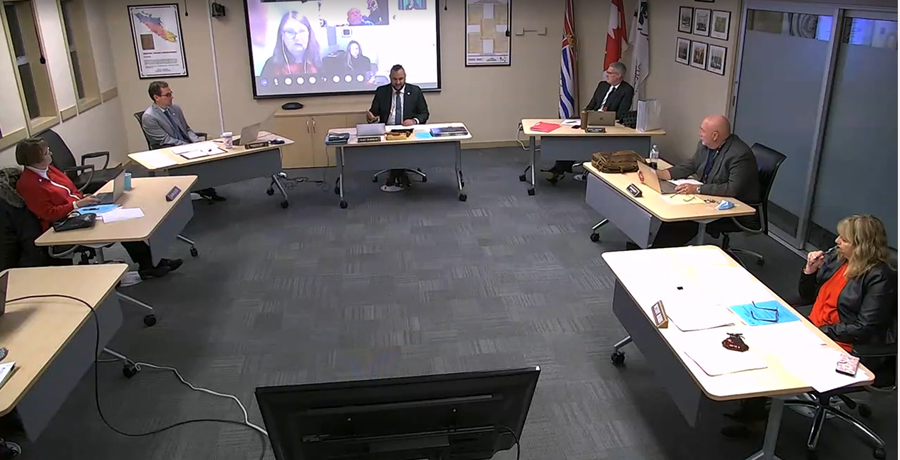
There was one outbreak in a public school in Greater Victoria (SD61) this fall (at Sir James Douglas Elementary in the Fairfield neighbourhood). A few smaller private schools in the Greater Victoria area have also had exposures this fall.
COVID during the holiday season:
With Christmas Eve and Christmas Day nearly upon us, people are hopefully now finalizing their plans to celebrate only with members of their immediate household (or if living alone, joining the household of someone — or having a visitor in — who is already in their COVID social bubble).
“With the holiday season here, we are all looking to find creative and safe ways to connect with our families, friends and loved ones,” said Dr Henry in her December 18 joint statement.
“For many, that means getting together virtually over a meal, watching holiday movie favourites or discovering new ways to connect safely from afar, such as a holiday bake-off over video conference or hosting an online games night or scavenger hunt with friends,” she says. Think about the impact that COVID has had on Internet bandwidth demand and wireless services this year, in support of activities like this where devices are running for lengthy periods of time.
Creative solutions:
“This holiday season is about finding ways to celebrate safely, knowing that what we are doing now will help ensure we can safely spend time with our loved ones in the new year,” says Dr Henry.
“For young people throughout the province, today is the final day of school ahead of the holiday break. There are many ways for young people to enjoy this special time of year. Take a night-time walk in your neighbourhood to look at local light displays. Consider dropping off baked goods or homemade gifts or cards to neighbours or those in long-term care to brighten someone else’s day.”
“Many of us will also be shopping in our local communities for last-minute gifts. We encourage everyone to be patient and kind to your fellow shoppers and to use your layers of protection to keep you, and those around you, safe.” Some stores have seen long lineups (mostly physically distanced) and most retail outlets have personnel taking care of how many people enter the store.
“This holiday season will be like no other. It will be a quieter time than what many of us are used to, but it is important to remember that we will get through this storm,” said Dr Henry today. The time for personal reflection during COVID has been significant (or at least more plentiful) for many people this year during the self-isolation imposed by the pandemic.
Doing this for better days ahead:
“The steps we take in the last days of 2020 are going to ensure a brighter, healthier and safer 2021 for all of us,” it was stated in the joint statement today by Dr Henry and Minister Dix.
While vaccinations have begun, very little of that has direct impact yet on the general population. Government leaders — from the prime minister on down — are talking about summer and fall of 2021 to seeing enough of the general population being immunized against COVID-19. The goal is for enough vaccination to achieve community (herd) immunity, which is generally thought to be around 70 percent of the overall population.
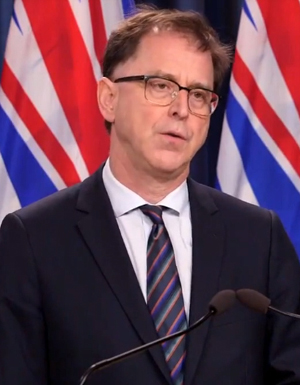
Hopefully the measures such as frequent hand washing and staying home when feeling unwell will stick even after COVID. The considerably diminished levels of influenza this fall and winter are probably a good indicator of how improved overall hygiene is paying off for overall health of the population.
Today Prime Minister Justin Trudeau delivered the mantra that what we do this Christmas is so we can have a more normalized Christmas next year, including with still the ones we love who will have been protected by appropriate public health measures during this ferocious pandemic.
Next BC COVID updates:
The next livestreamed COVID media update by Dr Henry and Health Minister Dix will be on Monday December 21 (usually at 3 pm, but sometimes at 3:30 pm). Following that, there will be a livestreamed update including the latest data modelling on Wednesday December 23 (usually at 3 pm, but sometimes at 3:30 pm).

===== About the writer:
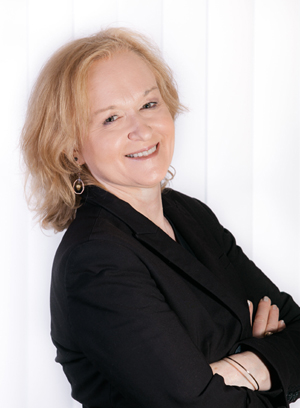
Island Social Trends editor Mary P Brooke, B.Sc., Cert PR, has –along with most other media in BC — been covering COVID non-stop all of this year. Her background in science (nutrition and biology) as well as studies in sociology, community education and mass media have supported her coverage of COVID this year. | This publication was founded by Ms Brooke in the west shore as a weekly newspaper in 2011, and before that was presented as a sociological examination of South Vancouver Island in a quarterly format as MapleLine Magazine.



